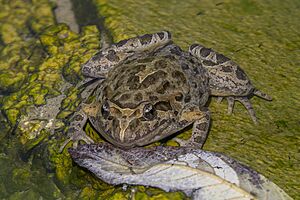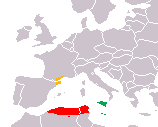Mediterranean painted frog facts for kids
Quick facts for kids Mediterranean painted frog |
|
|---|---|
 |
|
| In Malta | |
| Conservation status | |
|
Strictly Protected Fauna (Council of Europe (Bern Convention))
|
|
| Scientific classification | |
 |
|
| Green, D. p. pictus; red, D. p. auritus (native); orange, D.p. auritus (introduced) |
The Mediterranean painted frog, also called the painted frog, is a type of frog. Its scientific name is Discoglossus pictus. It belongs to the frog family Alytidae.
Contents
About the Mediterranean Painted Frog
Where Do They Live?
These frogs live in parts of North Africa. You can find them in Morocco, Algeria, and Tunisia. They also live on the islands of Sicily (Italy) and Malta.
Some painted frogs have been brought to new places. They now live in northeastern Spain and southwestern France. Another frog, Discoglossus scovazzi, was once thought to be the same species. But scientists now know they are different.
What Do They Look Like?
As their name suggests, these frogs can be very colorful! They have three main patterns. Some are mostly one color. Others have big, dark spots with bright edges. A third type has two dark brown stripes along its back. It also has a bright stripe down the middle. Two more bright stripes run along its sides.
Their bellies are usually whitish. The frog's body is strong and round. Its head is flat and wider than it is long. Some frogs have special glands on their back. These glands can form lines or might not be there at all. Their pupils, the dark part of their eyes, look like an upside-down teardrop.
Life Cycle and Reproduction
In North Morocco, these frogs mate for many months. This happens from January until early November. The male frog holds onto the female's lower back. This can last for about two hours. However, in Spain, this process is much quicker. It only lasts from 35 seconds to 2 minutes!
Female frogs lay many eggs in one night. They can lay between 500 and 1000 eggs! Females often mate with different males. After each mating, they lay a small group of eggs. Each group has about 20 to 50 eggs.
The eggs themselves are tiny, about 1.0 to 1.5 millimeters wide. They are surrounded by a jelly-like layer. This layer makes them 3 to 7 millimeters wide. The eggs do not stick together in one big clump. They form a loose mass on the water's surface. Sometimes, they sink to the bottom.
The eggs usually hatch in 2 to 6 days. When they hatch, the tadpoles are very small. They are only about 3 millimeters long. In 1 to 3 months, they grow to about 33 millimeters. Then, they change into tiny froglets. These young frogs are about 10 millimeters long.
In Sicily, many painted frogs live near human-made water sources. These include stone tanks, irrigation pipes, and canals. They are often found in areas where people grow crops.
Their Home and How They're Protected
These frogs face some challenges. Modern farming methods can harm their homes. However, frogs living near rivers, ponds, and swamps seem safer.
In some areas, like the Iberian Peninsula, these frogs are introduced. They might compete with other native frog species. This can happen when they share the same water. In North Africa, the painted frog is very common. Especially in the northern, wetter regions. They can even be found in oases in drier areas.
On the island of Malta, their numbers are decreasing. This is because the amount of groundwater is going down. Another frog, the Levant water frog, was brought to Malta. This frog competes directly with the painted frog for food and space.
To help protect these frogs, scientists need more information. They need to learn more about their daily lives and how they grow. It seems that painted frogs often use water bodies made by humans. This is true for at least some parts of their home range.


